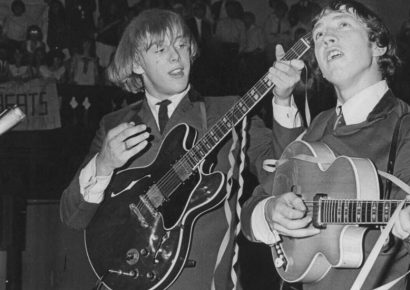For many newcomers to the engineering and mixing world, knowing what and how to achieve stereo width can be rather daunting indeed
Since the 1960s we’ve enjoyed all the wonders of audio mixing in stereo playback when listening to our favourite records. While there are countless classics that sounds absolutely superb in mono, there truly is something magical when listening in stereo; with a level of depth, space, and width that is oh so alluring to the human ear. This is only but enhanced with the wealth of surround and immersive formats available now, becoming ever more prevalent and attainable for the everyday music listener.
Audio mixing
Read all the latest features, interviews and how-to columns here.
When talking stereo with relation to mixing though, the first word that probably springs to mind is width. Creating width in a stereo mix is pretty paramount, particularly when analysing how many people listen to music in headphones and/or ear buds. Enhancing the stereo image whenever possible is going to bring a more immersive and exciting listening experience, without getting carried away of course.
For many newcomers to the engineering and audio mixing world, knowing what and how to achieve stereo width can be rather daunting indeed. While there’s a plethora of techniques, plugins, outboard gear, and alike available to help one grasp the farthest reaches of the stereo universe, we’re going to focus on modulation and how it alone can help enhance width in the stereo field.
Modulation in a nutshell
Modulation in relation to audio effects can be classified into a handful of specific effects, most commonly being, chorusing, flanging, and phasing. While the differences between theses effects on paper are fairly subtle, in relation to how they can effect a sound source can be wildly different indeed. And, while technically modulation effects are in fact time based, the delay lines are so short (1ms – 40ms), the human ear doesn’t detect them as being separate from each other and thus, aren’t categorised as “delay”.
Here’s a very basic breakdown of the main three categories to help differentiate them.
Phasing – Essentially no delay or very short (less than 1ms – 4ms). The delayed signal is phase shifted and blended back in with the original signal. This created a series of frequency cancellations (or notches) of varying frequencies (comb filtering), spaced evenly across a specific frequency spectrum.
Sounds like – whooshing.
Flanging – Very short delay (2-10ms). Dry/original signal mixed in with the delayed, varying copy of itself. Deep, with a lot of frequency cancellation, a sweeping comb filter (phasing).
Sounds like – a jet plane, waves, or swooshing.
Chorusing – Slightly longer delay (5-30ms). Original signal has multiple delays added with very subtle varying levels of detuning or phase shifting with their respective amplitudes modulated by a low frequency oscillator (LFO).
Sounds like – under water, bubbly, whoozy, airy, sea sick.
Now that we have a basic description of the main three types of modulation effects, let’s breakdown how modulation effects in audio mixing can enhance the stereo width.
Haas to be heard
As mentioned earlier, modulation effects aren’t categorised as delays as the human ear doesn’t perceive the short delay time between the original and delayed/effected sounds as being separate from one another. This is explained by the binaural psychoacoustic phenomenon known as the precedence effect or similarly, the Haas Effect, named after Dr Helmut Haas. A rabbit hole well worth exploring for those interested in a deeper understanding.
Utilising the Haas Effect in audio mixing can bring a phenomenal amount of perceived stereo width, without needing to use sometimes more obvious effects such as delay or reverb. A great example of this would be a double-tracked guitar part, which in essence is chorusing. Even the most esteemed guitar players can’t play the same guitar part exactly the same, ahhh the wonders of being innately human. These, (subtle as they may be) differences between the two performances of the same part, when panned hard left and right in the stereo field give an immediate sense of enhanced stereo width. The subtle differences of timing, pitch, and dynamics from the doubled performance, cumulatively adds up, modulating against the original part giving this added sense of depth, breadth, and most prominently, width.
Let’s say you wanted to give a guitar part a similar sense of width and depth as above, but you only had one take of that part in the session. Simply duplicating the part and panning the the original and duplicate left and right isn’t going to do a thing and will just sound, well, mono. However, inserting a chorus or other modulation type plugin or sending the audio to a plugin (or piece of hardware) placed on an aux track will immediately help create this type of width and depth; without the need to get the guitar player in to play the part again.
Dialling in just the right amount of depth or pitch modulation (if these parameters are available) will determine how “effected” the part will sound, so experimenting with the various parameters available will help find the sense of space, dimension, and width required. And be sure to always check this within the context of the mix, i.e. un-soloed.
Sure, it can be easy to go overboard and makes these types of effects way too obvious, just like anything right? But if used appropriately, modulation has the ability to trick the human ear into thinking there’s much more going on than there actually is.
A classic example of this would be ADT, or Artificial (automatic) Double Tracking, discovered by Abbey Road engineer Ken Townsend in the 1960’s. Just throw on a Beatles record from the mid-’60s onwards and you’ll surely spot the sound of ADT on John Lennon’s voice, which became part of his signature vocal sound there after.
A little goes a long way
While there are a bunch of other ways to achieve heavenly amounts of stereo width such as the use of other effects like delays, reverbs, or specific stereo imaging tools, the way that modulation effects can interact with the human ear can yield very aurally pleasing results.
Albeit a little more subtle in its “widening” of a stereo mix compared to other effects or techniques, adding modulation effects to sound sources such as vocals (lead or backing), mono recorded synths, percussion, and numerous other sources can help find their place in a mix, subtly stretching them out within the stereo field, adding character, vibe, depth and width.
A couple of parameters to be aware of as to not overcook things, is pitch variation, depth and if placed directly onto a track, the mix knob. Seasoning these effects to taste is always going to achieve the best results and the more cohesive stereo image.
Read more about Helmut Haas and his precedence effect here.







